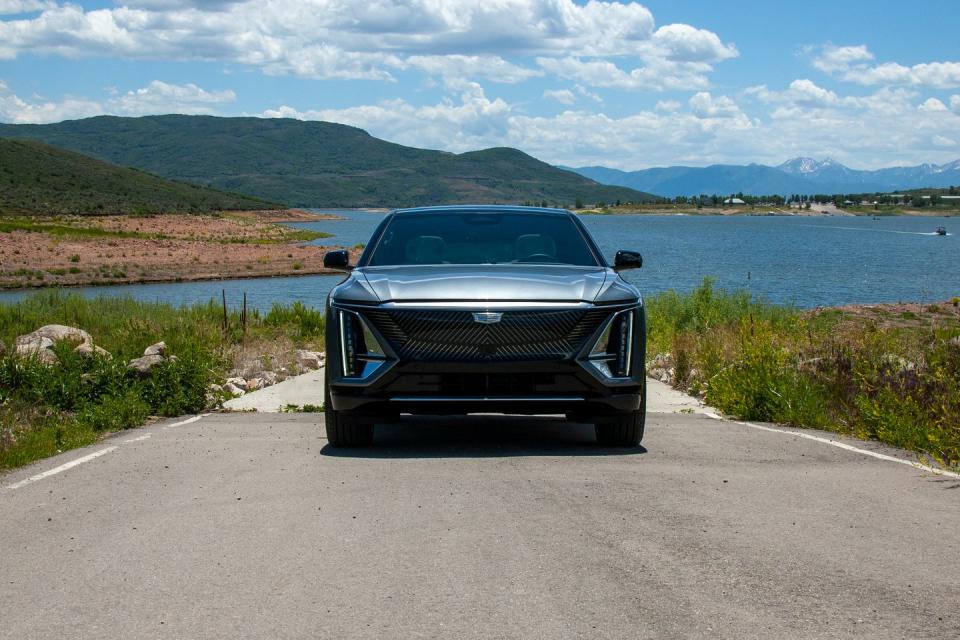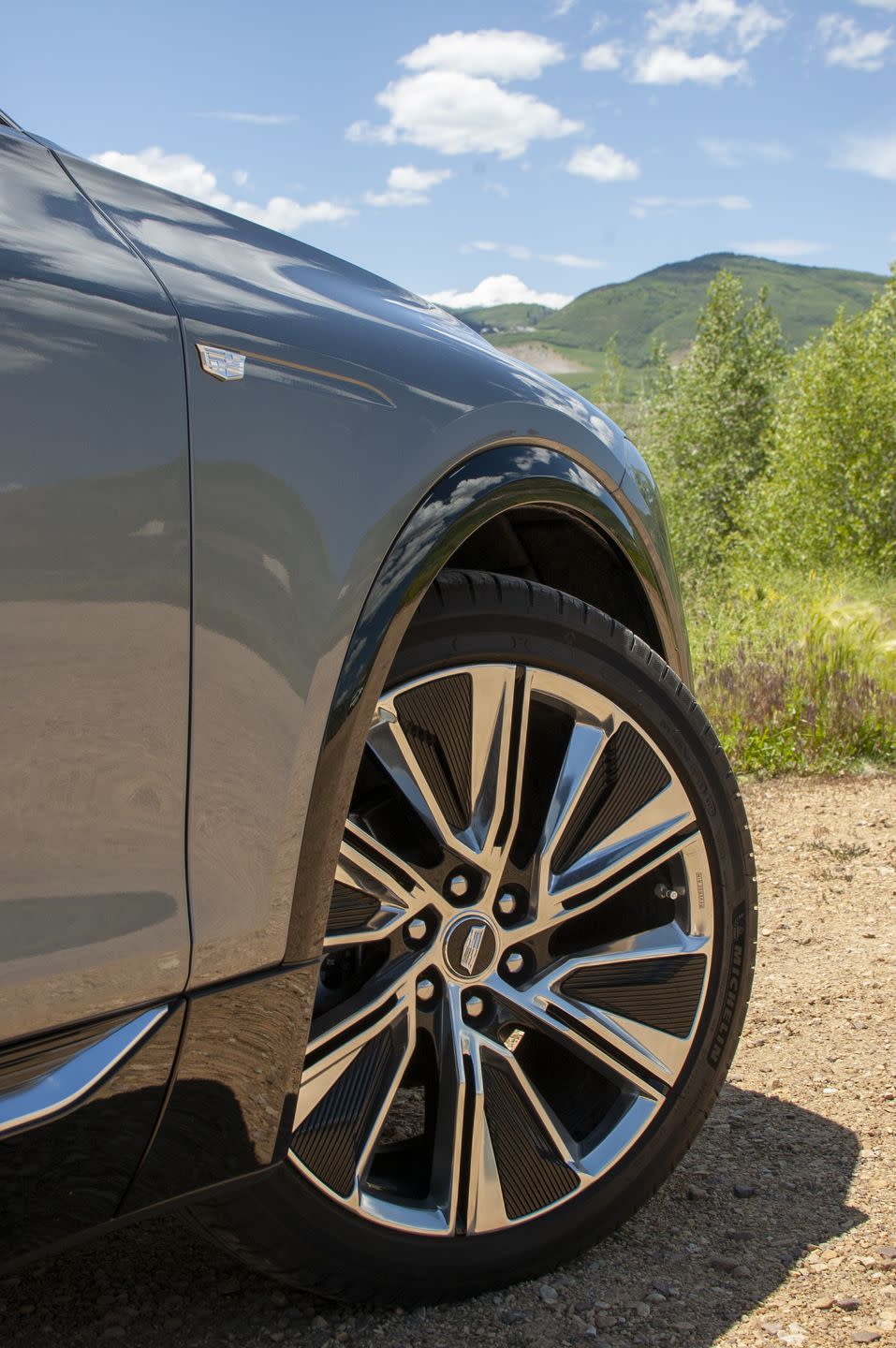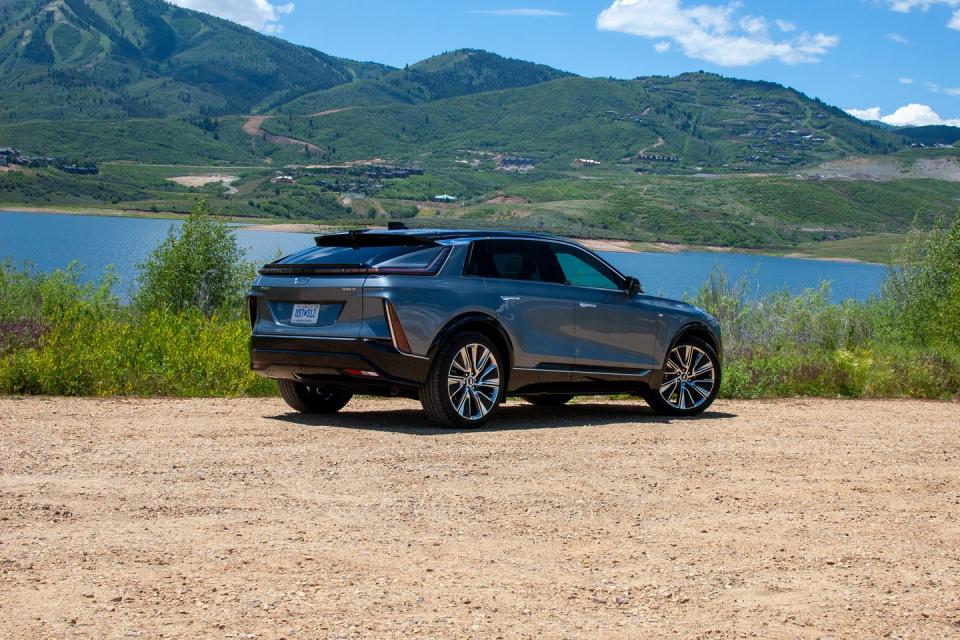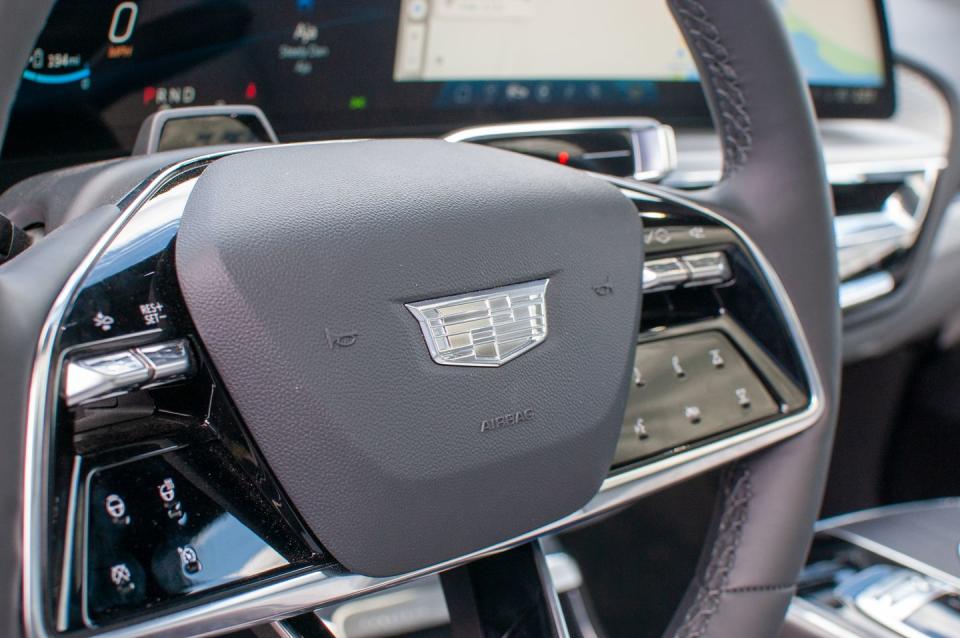The 2023 Cadillac Lyriq Is the Right Car at the Right Time

For years now, it's been frustratingly obvious that Cadillac was capable of building a vehicle that hit on all fronts. It made dynamically excellent and great-looking sedans with disappointing interior trimmings and tech, which arrived as Americans were moving towards crossovers and SUVs in huge numbers. Cadillac's SUVs, meanwhile, weren't particularly competitive in any regard, the Escalade the exception that proves the rule. If only the people who created Cadillacs were given the license to build something not only great, but that American luxury-car buyers actually want.
The Lyriq is that car. GM's new Ultium electric-car architecture and directives from CEO Mary Barra on down have finally let Cadillac show what it's capable of. The result is a thoroughly excellent luxury EV crossover, and one that is priced so competitively that it's impossible to ignore.

After the Hummer EV pickup, this is the second car using GM's Ultium architecture to reach production. In not being a $100,000, 10,000-pound monster truck, the Lyriq is the first Ultium car that feels truly relevant. The Ultium platform is, essentially, a floor pan made up of battery-cell modules that define the length of the car. What happens above the floor can vary wildly vehicle-to-vehicle. So, the Lyriq gets a 12-module, 102-kWh battery pack that provides for an EPA-estimated 312 miles of range and a unique five-link front and rear suspension. Right now, Cadillac is offering the Lyriq in one well-equipped trim level with either a single motor at the rear or a motor for each axle. The all-wheel drive car is a few months from production, so we drove a rear-drive 2023-model-year car. (Currently, production for 2023 is sold out, but you can order a 2024-model-year Lyriq with deliveries expected next spring.
Park City, Utah is almost comically gorgeous, splitting the difference between Alpine ski town and desert oasis. Head into the mountains and you'll find fast, gently curving roads, with wonderfully smooth surfaces. Here, the Lyriq is lovely.
Despite this being, you know, the future of Cadillac, the Lyriq takes a traditional approach to achieving excellent ride and handling. The Lyriq is a heavy vehicle—5610 pounds for this rear-drive version, 5915 for the all-wheel drive version—yet the battery pack contributes to a low center-of-gravity, and Cadillac was able to achieve a near 50:50 weight distribution. The integration of batteries with the body shell makes for a very stiff structure, which is essential for allowing a suspension to do its best. There are no fancy chassis electronics here—just high-quality twin-tube passive dampers, and a relatively soft setup with generous wheel travel. This sort of setup is advantageous for saving weight and cost—plus, active suspension hardware drains on the battery, further reducing range—yet it doesn't feel like a compromise whatsoever.

Like Cadillac's sport sedans, the Lyriq breathes well with the road surface but never wallows. You have to wait a moment for the car to take a set in wide, fast corners, but once it does, there's plenty of grip from the Michelin Primacy all season tires. Steering seems initially slow at first, but it does a good job of letting the driver know what's happening at the road surface. Cadillac mounts the front suspension on a cradle which is then rigidly mounted to the body to ensure steering precision. The rear suspension cradle is isolated with rubber bushings to maintain ride quality.
The Lyriq also serves as a good reminder that you don't need adaptive dampers when the fundamentals of the chassis are so strong. Sure, GM's magic MagneRide dampers could provide even greater bandwidth between soft and firm in a future "V" version of the Lyriq—which while unconfirmed, seems almost certain—yet for this standard-issue version, they're unnecessary. All of Cadillac's testers were fitted with 22-inch wheels and 40-profile tires, which are usually a disaster for ride quality. Here, though, if you didn't know any better, you'd think these were 20s.

The weight of the car is felt most acutely under heavy braking, though it should be noted that braking performance is strong and pedal feel is superb. To better manage the transition between regenerative and friction braking, Cadillac did the brake calibration in-house rather than relying on a third-party supplier. As with Cadillac's current sedans and the C8 Corvette, the electronic brake booster allows for user-selectable pedal feel, but in both normal and sport settings, there's immediate bite at the very top of the pedal, and it's incredibly easy to modulate. You really can't tell where the regen stops and the friction starts, and vice versa, which isn't true of all electrified cars.
Three-hundred forty horsepower and 325 lb-ft of torque provide for ample acceleration from a stop, though the Lyriq isn't a neck-snapper like some luxury EVs. Not that it really matters, ultimately. How quick, really, do you need your luxury family crossover to be? If the answer is quicker than this, wait for the 500-hp all-wheel drive version. Plus, the Lyriq carries speed very well. It's all too easy to cover ground at 20-30 mph over the limit.
That's also because the Lyriq is so silent, it's almost uncanny. A mix of traditional sound deadening material and an active-noise canceling system mean that even at 85 mph, you really only hear very well-suppressed wind noise. Particularly clever is the usage of accelerometers on the wheels that predict the pitch and volume of tire noise and use the speakers to cancel out that noise a la noise canceling headphones.

In normal driving, it's a pleasure to use the Lyriq. It's maneuverable despite its 196.7 inches in overall length, and like a good luxury car should, it isolates you from the outside world. GM's excellent SAE Level 3 Supercruise driver-aid system comes standard, though it won't be activated until later this year by an over-the-air update. The interior is, perhaps, Cadillac's best ever, with a fairly minimalist design centered around a 33-inch curved OLED display that houses both the gauge cluster and infotainment system. It looks fabulous and it's easy to use, though some other journalists at this Cadillac event reported some bugs and even screens shutting down. My only issue was the screen flickering on and off a couple of times. Cadillac says its test cars were early builds, and it has two software updates planned before customer deliveries begin next month that should address any issue.
Probably the best thing about the infotainment system is that the inbuilt navigation system is just Google Maps, so finally, there's a better alternative to using Apple CarPlay and Android Auto (though both are available wirelessly). The rest of the system isn't as slick as, say, BMW's latest iDrive, but it's very easy to use, with a mix of touchscreen control and a rotary wheel in the center console.
Cadillac made a big deal about how it was able to develop its own brand-unique switchgear for the Lyriq, instead of relying on the GM parts bin. Most of it is quite nice, and does a good job of elevating the cab above recent Cadillac interiors, even if some components—notably the rotary infotainment controller—look great but feel cheap. The Genesis GV60 Performance I tested a few weeks ago still has the Lyriq beat for overall interior quality, especially with the feel of the leather, yet that car costs a few thousand dollars more and is much smaller. I also wish there was a dedicated drive mode button. The settings are buried on the second page of the infotainment system, and while users can place a shortcut button at the bottom of the screen, a button on the steering wheel would be ideal.
Overall though, the Lyriq's interior is up there with anything Mercedes is doing for similar money, and it's hard not to overstate how big of a deal that is. Generations of Cadillacs since the brand's “Art and Science” period began with the original CTS in 2002 have been ultimately felled by interiors that simply weren't good enough. This interior, by contrast, is a knockout.
The 2023 rear-drive Lyriq comes in one very well-equipped trim for $62,990, though Cadillac offered a handful last year for early reservation holders at just $59,990. For 2024, Cadillac says the rear-drive model will start around $60,000 with the all-wheel drive starting at $64,000. For the money, there isn't a better luxury EV out there, and notably, the Lyriq undercuts the Tesla Model Y Long Range while offering similar range and performance and a far better interior.

I asked Cadillac directly if they're losing money on these cars. The Lyriq's Chief Engineer, Jamie Brewer, said simply that Cadillac is a for-profit company, while brand president Rory Harvey just acknowledged that it was priced "aggressively." Given what's here, I suspect the Lyriq is not intended to be a big profit-generator, but instead something to win over desperately needed new customers to the brand. If a great-driving, wonderfully designed, luxurious crossover doesn't do that, nothing will.
Perhaps the best thing about the Lyriq is what it portends for the future. Cadillac's stated goal is to be all electric by 2030, though Rory Harvey says that could happen sooner depending on customer response. The Lyriq is, essentially, the replacement for the XT5—though that gas-powered crossover will continue in production for some time—and a smaller electric car replacing the XT4 is due next year. Plus, Cadillac is working on more high-performance cars. Given they'll all share DNA with the Lyriq, there's a lot of good coming.
Not since the original Escalade has Cadillac had such a right car at such a right time. If you're rooting for Cadillac's success, the Lyriq brings with it a sigh of relief. Finally—finally!—Cadillac has a near-certain hit. On so many levels, the Lyriq is worth the wait.
You Might Also Like

 Yahoo Autos
Yahoo Autos 